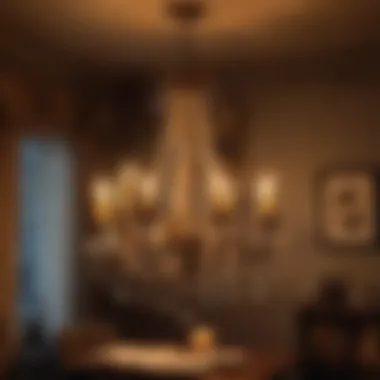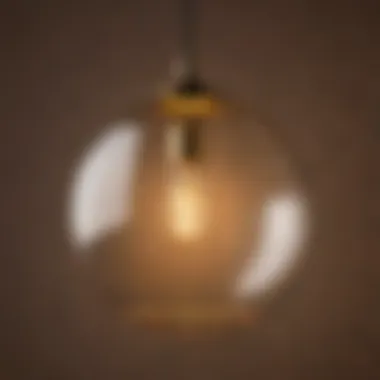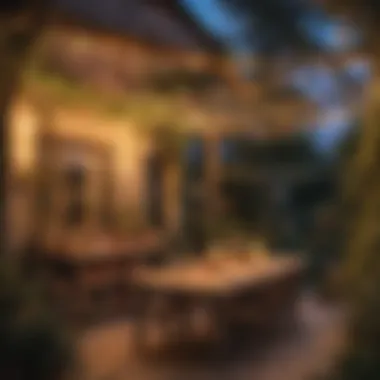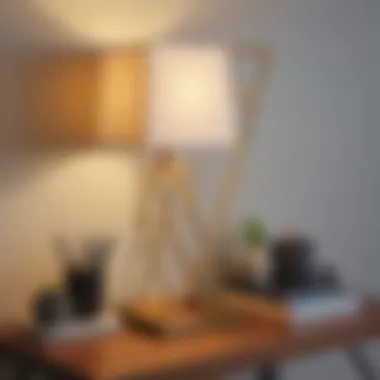Mastering the Craft: The Ultimate DIY Guide to Crafting Your Own Lights


Science Fun Facts
Let's kick off our exploration into the world of lighting with some fascinating science fun facts. Did you know that the first electric light was invented in 1802 by Humphry Davy? Imagine a world without the convenience of turning on a light switch! Another intriguing fact is that light travels at a speed of approximately 186,282 miles per second. This incredible speed allows us to see objects instantaneously when light reflects off them.
Discover the Wonders of Science
As we delve deeper into the art of making your own lights, we uncover the wonders of science that govern this captivating process. From understanding how light is produced to exploring different color temperatures and brightness levels, the science behind illumination is truly mesmerizing. Educational videos and animations further enhance our learning experience by providing visual representations of complex scientific concepts. Real-life applications of science in lighting design demonstrate the practical significance of illuminative knowledge.
Science Quiz Time
Engage in some interactive learning with our science quiz time segment. Test your knowledge on light and lighting design through a series of thought-provoking questions and brain teasers. Challenge yourself with multiple-choice questions that will stimulate your curiosity while fostering a deeper understanding of the concepts discussed in this DIY guide. Learning through gamification not only makes the process enjoyable but also reinforces your comprehension of key principles.
Science Experiment Showcase
Dive into the world of hands-on exploration with our science experiment showcase. Unleash your creativity by engaging in fun and engaging experiments to create your own lights. Follow step-by-step instructions carefully crafted to ensure successful project completion. A comprehensive materials list guides you in gathering everything you need for your DIY lighting endeavors. Remember to prioritize safety by adhering to the provided tips and precautions, ensuring a secure and educational experiment.
Introduction to Making Your Own Lights
The world of creating your own lights opens up a realm of possibilities for illumination enthusiasts. In this article, we will delve deep into the art of crafting your lighting fixtures, providing a step-by-step guide for beginners and experienced DIYers alike. Understanding the basics of lighting is key to mastering the craft, from the science behind light to the different types of lighting sources available.
Understanding the Basics of Lighting
The Science Behind Light
When we explore the science behind light, we uncover the fundamental principles that govern how light interacts with our surroundings. The properties of light, such as wavelength and intensity, play a crucial role in defining the ambiance and functionality of lighting fixtures. Understanding these concepts is essential for creating lights tailored to specific requirements, whether for task lighting or creating a cozy atmosphere. While the science behind light may seem intricate, its application in DIY projects offers endless creative possibilities.
Types of Lighting Sources
Diving into the various types of lighting sources introduces us to a plethora of options for our DIY projects. From incandescent bulbs to energy-efficient LEDs, each lighting source comes with its unique characteristics and advantages. Exploring these types enables enthusiasts to customize their lighting solutions based on factors like energy efficiency, color rendering, and longevity. Selecting the right lighting source plays a significant role in the effectiveness and appeal of your DIY light fixtures.
Tools and Materials Needed
Essential Tools for DIY Lighting Projects


Equipping yourself with the necessary tools for DIY lighting projects is the first step towards successful craftsmanship. Tools such as wire cutters, electrical testers, and soldering irons are indispensable for assembling and wiring light fixtures. Each tool serves a specific function in the creation process, ensuring precision and efficiency in your projects. Having a well-stocked toolbox contributes to a seamless workflow and professional results.
Selecting the Right Materials
In addition to tools, selecting the right materials is a critical aspect of DIY lighting projects. From durable metal fixtures to heat-resistant wiring, choosing high-quality materials ensures the longevity and safety of your creations. Factors like aesthetics, functionality, and sustainability come into play when deciding on materials for your light fixtures. Striking a balance between practicality and visual appeal enhances the overall design and performance of your DIY lights.
Safety Precautions
Importance of Proper Safety Gear
Prioritizing safety when embarking on DIY lighting projects is non-negotiable. Proper safety gear, including goggles, gloves, and fire extinguishers, protects you from potential hazards like electric shocks and burns. Adhering to safety practices minimizes risks and fosters a secure working environment for your projects. Investing in quality safety equipment is an investment in your well-being and the success of your lighting endeavors.
Handling Electrical Components Safely
Handling electrical components with care is paramount to the success of your DIY lighting projects. Understanding the basics of electricity, such as voltage and current, helps in safely connecting and testing light fixtures. Implementing insulation techniques and following wiring diagrams prevent short circuits and ensure proper functionality. Safely handling electrical components not only guarantees the longevity of your creations but also shields you from potential accidents.
DIY Lighting Techniques
DIY Lighting Techniques play a crucial role in this article, as they serve as the backbone for individuals interested in creating their own lights. By delving into the specifics of DIY Lighting Techniques, enthusiasts can grasp the intricacies involved in illuminating their spaces, from conceptualization to execution. Understanding DIY Lighting Techniques empowers individuals to customize their lighting solutions, tailoring them to their preferences and needs. Emphasizing DIY Lighting Techniques enhances readers' expertise in crafting unique and personalized lighting fixtures.
Creating a Basic Light Fixture
When considering Creating a Basic Light Fixture, one must first delve into assembling the components. Assembling the Components involves meticulously putting together the essential parts required for a functional lighting fixture. This process showcases the essence of DIY lighting, allowing individuals to understand the inner workings of a basic light setup. The key characteristic of Assembling the Components lies in its foundational nature, laying the groundwork for more complex lighting projects. Despite its simplicity, assembling components remains a popular choice for DIY projects due to its hands-on approach and practical implications.
Discussing Wiring and Connection Methods in the context of Creating a Basic Light Fixture is essential for ensuring the functionality and safety of the lighting setup. Wiring and Connection Methods focus on the electrical aspect of the project, detailing how to properly connect each component to guarantee optimal performance. The key characteristic of Wiring and Connection Methods is their role in creating a seamless electrical system within the light fixture. Although wiring may seem daunting to beginners, understanding these methods is crucial for successful DIY lighting projects. While the intricacies of wiring can be challenging, mastering this aspect adds a layer of accomplishment to the overall project.
Experimenting with Light Bulbs
Experimenting with Light Bulbs introduces enthusiasts to the diverse world of lighting options available for customization. Exploring Different Bulb Types allows individuals to understand the nuances between various bulbs, such as incandescent, fluorescent, and LED, and their unique characteristics. This exploration empowers enthusiasts to make informed decisions based on their lighting requirements and preferences. Choosing the right bulb type is essential for achieving the desired lighting effect, whether it's ambient, task-oriented, or decorative.
Customizing Light Output serves as a creative outlet for individuals looking to personalize their lighting solutions further. By customizing light output, enthusiasts can adjust brightness levels, color temperatures, and directional lighting to suit different settings and moods. The key characteristic of Customizing Light Output is its versatility, offering endless possibilities for tailoring lighting effects to specific needs. While customization enhances the aesthetic appeal of lighting fixtures, it also contributes to creating a comfortable and functional lighting environment.
Innovative Lighting Designs


Innovative Lighting Designs bring a modern twist to DIY lighting projects, incorporating cutting-edge technologies for superior illumination. Integrating LED Technology revolutionizes the way light fixtures operate, offering energy-efficient and long-lasting lighting solutions. LED technology's key characteristic lies in its durability and low power consumption, making it an environmentally friendly choice for sustainable lighting designs. Embracing LED technology demonstrates a forward-thinking approach to lighting design, aligning with contemporary trends.
Designing Eco-Friendly Lights emphasizes the importance of sustainability in lighting design, encouraging enthusiasts to use eco-conscious materials and techniques. The key characteristic of Designing Eco-Friendly Lights is its contribution to reducing environmental impact through energy conservation and waste reduction. By incorporating eco-friendly practices into lighting designs, individuals can create aesthetically pleasing fixtures that are also environmentally responsible. Designing eco-friendly lights not only promotes sustainable living but also inspires others to adopt greener practices in their DIY projects.
Advanced Concepts in Lighting Design
Understanding Light Color and Temperature plays a crucial role in the realm of lighting design. It serves as the foundation for creating captivating and dynamic lighting arrangements that can elevate any space to new heights of atmosphere and functionality. By grasping the intricacies of light color and temperature, DIY enthusiasts can unlock endless possibilities for customization and aesthetic appeal in their lighting projects. The ability to manipulate color temperature allows for the creation of unique moods and ambiances, giving individuals the power to tailor their lighting to suit specific needs and preferences. Furthermore, a deep understanding of these concepts enables enthusiasts to design lighting solutions that are not only aesthetically pleasing but also highly functional and efficient.
Understanding Light Color and Temperature
Impact of Color Temperature on Ambiance
Color temperature plays a pivotal role in shaping the ambiance of a space. By adjusting the color temperature of light sources, individuals can evoke different emotions and set varying tones within a room. Warm color temperatures create a cozy and inviting atmosphere, perfect for lounging or relaxation areas. On the other hand, cool color temperatures energize a space, making them ideal for workspaces or areas where focus and productivity are essential. Understanding the impact of color temperature empowers DIYers to craft lighting schemes that align with the desired mood and purpose of the space. Experimenting with different color temperatures allows for endless creative expression and customization in lighting design, enhancing the overall visual experience.
Creating Mood Lighting Effects
Mood lighting effects add an extra layer of depth and sophistication to lighting designs. By strategically incorporating mood lighting, individuals can transform the ambiance of a room effortlessly. Whether it's through subtle accent lighting, color-changing LEDs, or dimmable fixtures, mood lighting allows for dynamic adjustments to suit various occasions and moods. The versatility of mood lighting effects enables DIY enthusiasts to create striking visual narratives within their spaces, highlighting specific areas or features for emphasis. By mastering the art of creating mood lighting effects, individuals can elevate their lighting projects from functional to artistic, adding a personal touch that distinguishes their designs.
Incorporating Smart Lighting Solutions
The integration of smart lighting solutions revolutionizes the way individuals interact with and control their lighting systems. By incorporating automation and control systems, DIYers can experience newfound convenience and flexibility in managing their lights. Automation features allow for the programming of lighting scenarios based on daily routines or specific needs, enhancing comfort and efficiency. Moreover, smart lighting solutions enhance connectivity with the Internet of Things (IoT), enabling seamless integration with other smart devices for a holistic and interconnected living experience. The ability to remotely control and customize lighting settings adds a layer of futuristic sophistication to DIY lighting projects, offering unparalleled convenience and functionality.
Automation and Control Systems
Automation and control systems streamline the management of lighting setups, offering users the ability to schedule, adjust, and monitor their lights with ease. By automating lighting processes, individuals can optimize energy usage, create personalized lighting scenes, and enhance overall comfort within their spaces. The convenience of automation systems transforms everyday lighting routines into seamless and intuitive experiences, enhancing both practicality and ambiance in various settings. Embracing automation in lighting design empowers DIY enthusiasts to achieve tailored lighting solutions that suit their lifestyle and preferences, ensuring optimal comfort and energy efficiency.
Enhancing Connectivity with IoT
Enhancing connectivity with the Internet of Things (IoT) opens up a world of possibilities in smart lighting solutions. By linking lighting systems to interconnected IoT networks, individuals can control their lights through voice commands, mobile apps, or integrated smart home hubs. This connectivity not only simplifies the management of lighting setups but also enables enhanced customization and integration with other smart devices. With IoT compatibility, DIYers can create immersive lighting experiences that respond to environmental cues, user preferences, and external factors, making their lighting designs truly intelligent and adaptive. The seamless connectivity offered by IoT bridges the gap between technology and creativity, empowering individuals to craft innovative and responsive lighting solutions that enhance both functionality and aesthetics.
Sustainable Lighting Practices
In an era of environmental consciousness, sustainable lighting practices have emerged as a vital aspect of lighting design. By prioritizing energy-efficient lighting strategies and the upcycling and repurposing of materials, DIY enthusiasts can contribute to a greener and more eco-friendly approach to illumination. Sustainable lighting practices not only reduce energy consumption and environmental impact but also foster creativity and resourcefulness in the design process. By adopting sustainable approaches in lighting design, individuals can create lighting solutions that not only enhance aesthetics but also promote sustainability and responsible use of resources.


Energy-Efficient Lighting Strategies
Energy-efficient lighting strategies focus on maximizing the output of light while minimizing energy consumption. By utilizing LED technology, dimmable fixtures, and sensor-based controls, individuals can significantly reduce their carbon footprint and energy bills. Energy-efficient lighting not only contributes to environmental preservation but also enhances the longevity of lighting systems, reducing maintenance costs and increasing operational efficiency. Embracing energy-efficient strategies in DIY lighting projects not only benefits the environment but also enhances the overall sustainability and cost-effectiveness of lighting designs. By optimizing energy usage and reducing waste, individuals can craft lighting solutions that are both environmentally conscious and economically prudent.
Upcycling and Repurposing Materials
Upcycling and repurposing materials offer a sustainable and creative approach to lighting design. By giving new life to old or discarded items, DIY enthusiasts can create unique lighting fixtures that boast individuality and character. Upcycled lighting projects not only reduce waste but also add a touch of history and storytelling to the design, making them standout conversation pieces in any setting. Repurposing materials such as glass bottles, industrial pipes, or reclaimed wood allows for endless creativity and customization, enabling individuals to express their unique style and ethos through their lighting designs. Embracing upcycling and repurposing in lighting projects not only showcases ingenuity and resourcefulness but also echoes a commitment to sustainability and thoughtful design.
Tips for Perfecting Your DIY Lights
In the realm of DIY lighting projects, one cannot overlook the significance of perfecting the final output. The meticulous attention to detail in fine-tuning your DIY lights can truly elevate the ambiance of any space. By focusing on enhancing the light intensity and distribution, you have the opportunity to create a custom lighting solution that caters specifically to your needs and preferences. From balancing ambient lighting to optimizing light placement, these tips will empower you to achieve a professional look in your DIY lighting projects.
Fine-Tuning Light Intensity and Distribution
Balancing Ambient and Task Lighting
The art of balancing ambient and task lighting plays a fundamental role in creating a harmonious lighting scheme. By carefully distributing light throughout a room, you can achieve a cohesive blend of general illumination and focused task lighting. The key characteristic of balancing ambient and task lighting lies in striking the right proportion between the two. This balance ensures that neither the ambient nor task lighting overwhelms the space but rather works in unison to provide both functionality and atmosphere. The unique feature of this lighting technique is its versatility; it adapts well to various room sizes and purposes, making it a popular choice among DIY lighting enthusiasts.
Optimizing Light Placement
Optimizing light placement entails strategically positioning light sources to maximize their effectiveness. By directing light where it is needed most, you can accentuate focal points in a room and improve overall visibility. The key characteristic of optimizing light placement lies in its ability to enhance the functionality and aesthetics of a space simultaneously. This technique is a beneficial choice for this article as it emphasizes the importance of thoughtful light positioning in DIY lighting projects. The unique feature of optimizing light placement is its capacity to transform a room's look and feel through intentional placement, showcasing the artistry of lighting design.
Maintenance and Troubleshooting
Cleaning and Care Recommendations
When it comes to DIY light projects, proper cleaning and care are essential for maintaining the longevity and performance of your fixtures. Regular cleaning not only enhances the appearance of your lights but also ensures optimal light output. The key characteristic of cleaning and care recommendations is their ability to prolong the lifespan of your DIY lights, reducing the need for frequent replacements. This technique is a popular choice for this article due to its practicality and cost-effectiveness. However, remember that improper cleaning methods can damage your fixtures, so it is crucial to follow the unique feature of cleaning and care recommendations for safe maintenance.
Common Issues and Solutions
Encountering common issues with your DIY lights is not uncommon, but being equipped with troubleshooting solutions can save you time and frustration. From flickering bulbs to faulty connections, understanding how to diagnose and resolve these issues is paramount. The key characteristic of common issues and solutions lies in their ability to empower DIY enthusiasts to address problems independently, fostering a sense of accomplishment and knowledge. This aspect is highly beneficial for this article as it equips readers with practical skills to overcome challenges in their lighting projects. The unique feature of common issues and solutions is their applicability to a wide range of DIY lighting scenarios, offering versatile solutions to common problems.
Showcasing Your DIY Light Projects
Photography Tips for Capturing Light Effects
Photographing your DIY light projects is an art in itself, requiring an understanding of light dynamics and composition. Capturing the mesmerizing effects of your lighting creations can amplify their visual impact and provide inspiration to others. The key characteristic of photography tips for capturing light effects is their ability to showcase the artistry and innovation behind DIY lighting designs. This aspect is particularly beneficial for this article as it accentuates the importance of presentation and documentation in lighting projects. The unique feature of photography tips for capturing light effects is their capacity to transform ordinary photos into captivating visual stories, enhancing the overall narrative of your DIY creations.
Sharing Your Creations Online
Sharing your DIY light projects online is a fantastic way to connect with a broader community of lighting enthusiasts and showcase your creativity. Whether through social media platforms or dedicated forums, sharing your creations allows you to receive feedback, inspire others, and document your creative journey. The key characteristic of sharing your creations online is its ability to foster a sense of community and encourage collaboration among DIY enthusiasts. This element is highly beneficial for this article as it encourages readers to engage with a like-minded audience and gain recognition for their innovative lighting designs. The unique feature of sharing your creations online is its potential to spark creativity and dialogue, creating a dynamic exchange of ideas and inspiration within the DIY lighting community.







